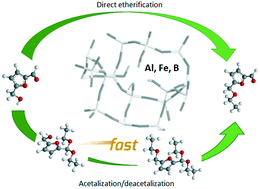当前位置:
X-MOL 学术
›
Catal. Sci. Technol.
›
论文详情
Our official English website, www.x-mol.net, welcomes your
feedback! (Note: you will need to create a separate account there.)
Direct versus acetalization routes in the reaction network of catalytic HMF etherification†
Catalysis Science & Technology ( IF 4.4 ) Pub Date : 2018-02-07 00:00:00 , DOI: 10.1039/c7cy02339a P. Lanzafame 1, 2, 3, 4, 5 , G. Papanikolaou 1, 2, 3, 4, 5 , S. Perathoner 1, 2, 3, 4, 5 , G. Centi 1, 2, 3, 4, 5 , M. Migliori 5, 6, 7, 8 , E. Catizzone 5, 6, 7, 8 , A. Aloise 5, 6, 7, 8 , G. Giordano 5, 6, 7, 8
Catalysis Science & Technology ( IF 4.4 ) Pub Date : 2018-02-07 00:00:00 , DOI: 10.1039/c7cy02339a P. Lanzafame 1, 2, 3, 4, 5 , G. Papanikolaou 1, 2, 3, 4, 5 , S. Perathoner 1, 2, 3, 4, 5 , G. Centi 1, 2, 3, 4, 5 , M. Migliori 5, 6, 7, 8 , E. Catizzone 5, 6, 7, 8 , A. Aloise 5, 6, 7, 8 , G. Giordano 5, 6, 7, 8
Affiliation

|
The etherification of HMF (5-hydroxymethylfurfural) to EMF (5-(ethoxymethyl)furan-2-carbaldehyde) is studied over a series of MFI-type zeolite catalysts containing different heteroatoms (B, Fe, Al), aiming to understand the effect of different isomorph substitutions in the MFI framework on the reaction pathways of HMF conversion. The rate constants in the reaction network are determined for these different catalysts and analyzed with respect to the amount of Brønsted and Lewis acid sites determined by FT-IR pyridine adsorption. Two different pathways of EMF formation, i.e. direct etherification and via acetalization, were evidenced. The Lewis acid sites generated from the presence of aluminum are primarily active in catalyzing direct HMF etherification to EMF, which has a rate constant about one order of magnitude lower than the etherification of the corresponding acetals. This behaviour is due to the competitive chemisorption between hydroxyl and aldehyde groups (both present in HMF) on the Lewis acid sites catalyzing the etherification. A cooperation phenomenon between Brønsted and Lewis acid sites is observed for the HMF acetal etherification to EMF acetal. In the reactions of direct HMF acetalization and deacetalization of the EMF acetal, the turnover frequencies for Silicalite-1 and B-MFI samples are about twice those for Fe-MFI and Al-MFI samples. This is attributed to the different reactivity of strong silanol groups associated with surface defects on the external surface in Silicalite-1 and B-MFI. These sites are also responsible for the EMF-to-EOP (ethyl 4-oxopentanoate) reaction step. In the deacetalization reaction of the EMF acetal, the behavior is determined from the presence of water (product of reaction) favouring the back reaction (aldehyde formation).
中文翻译:

催化HMF醚化反应网络中的 直接途径与缩醛途径†
在一系列含有不同杂原子(B,Fe,Al)的MFI型沸石催化剂上研究了HMF(5-羟甲基糠醛)醚化为EMF(5-(乙氧基甲基)呋喃-2-甲醛)的过程,旨在了解其作用。 MFI框架中不同同晶型取代对HMF转化反应路径的影响。对于这些不同的催化剂,确定反应网络中的速率常数,并针对通过FT-IR吡啶吸附测定的布朗斯台德和路易斯酸位点的数量进行分析。EMF形成的两种不同途径,即直接醚化和通过乙缩醛化被证明。由铝的存在产生的路易斯酸位点主要在催化直接HMF醚化为EMF方面具有活性,其速率常数比相应的缩醛的醚化低约一个数量级。此行为是由于在路易斯酸位点上催化醚化的羟基和醛基(均存在于HMF中)之间的竞争性化学吸附。对于HMF缩醛醚化为EMF缩醛,观察到Brønsted和Lewis酸位点之间存在合作现象。在直接HMF乙缩醛化和EMF乙缩醛脱缩醛反应中,Silicalite-1和B-MFI样品的周转频率大约是Fe-MFI和Al-MFI样品的周转频率的两倍。这归因于与Silicalite-1和B-MFI中外表面的表面缺陷相关的强硅烷醇基团的反应性不同。这些位点也负责EMF到EOP(4-氧戊酸乙酯)反应步骤。在EMF乙缩醛的脱缩醛反应中,其行为是通过水(反应产物)的存在来确定的,该水有利于逆反应(醛的形成)。
更新日期:2018-02-07
中文翻译:

催化HMF醚化反应网络中的 直接途径与缩醛途径†
在一系列含有不同杂原子(B,Fe,Al)的MFI型沸石催化剂上研究了HMF(5-羟甲基糠醛)醚化为EMF(5-(乙氧基甲基)呋喃-2-甲醛)的过程,旨在了解其作用。 MFI框架中不同同晶型取代对HMF转化反应路径的影响。对于这些不同的催化剂,确定反应网络中的速率常数,并针对通过FT-IR吡啶吸附测定的布朗斯台德和路易斯酸位点的数量进行分析。EMF形成的两种不同途径,即直接醚化和通过乙缩醛化被证明。由铝的存在产生的路易斯酸位点主要在催化直接HMF醚化为EMF方面具有活性,其速率常数比相应的缩醛的醚化低约一个数量级。此行为是由于在路易斯酸位点上催化醚化的羟基和醛基(均存在于HMF中)之间的竞争性化学吸附。对于HMF缩醛醚化为EMF缩醛,观察到Brønsted和Lewis酸位点之间存在合作现象。在直接HMF乙缩醛化和EMF乙缩醛脱缩醛反应中,Silicalite-1和B-MFI样品的周转频率大约是Fe-MFI和Al-MFI样品的周转频率的两倍。这归因于与Silicalite-1和B-MFI中外表面的表面缺陷相关的强硅烷醇基团的反应性不同。这些位点也负责EMF到EOP(4-氧戊酸乙酯)反应步骤。在EMF乙缩醛的脱缩醛反应中,其行为是通过水(反应产物)的存在来确定的,该水有利于逆反应(醛的形成)。











































 京公网安备 11010802027423号
京公网安备 11010802027423号